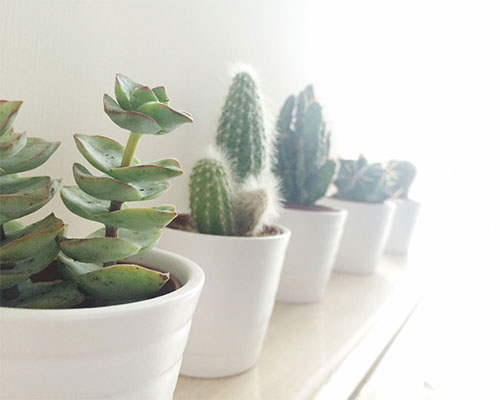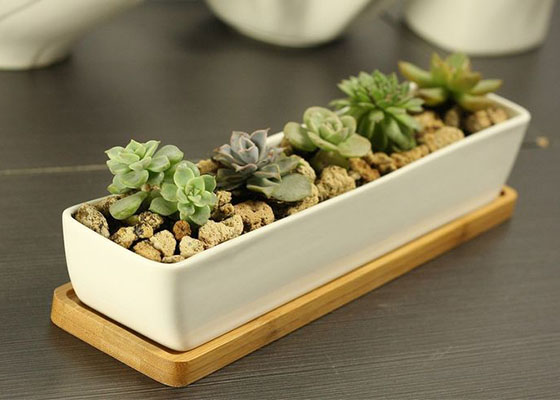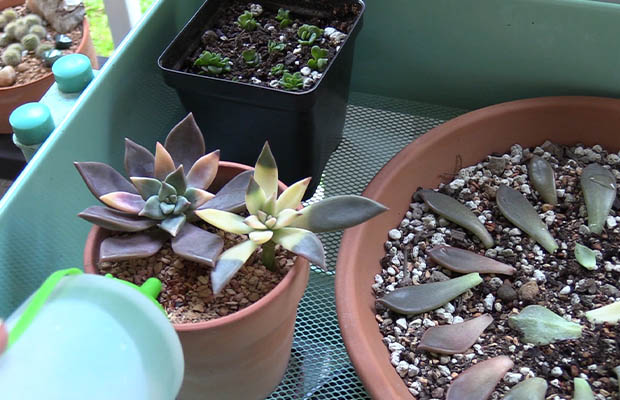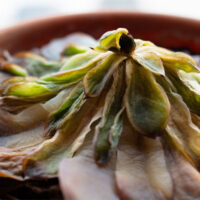Succulents are hardy little plants because they don’t need a lot of water to thrive. Succulents are not like most other plants. So naturally, if you try to water them like other plants, especially other houseplants, they won’t survive!
So how often to water succulents? Indoor succulent plants probably need to be watered once a week.
This post will take an in-depth look at how to water succulents, and relevant information about planting succulents.
Related Reading: How To Plant Succulents?
Table of Contents
What Are Succulents?
Succulent plants, also known as succulents, are a group of plants with tissues that can store water. Plants that are tolerant of drought include succulents. They have evolved to survive in extremely dry, arid environments. Usually, the leaves, stems, or roots of these plants act as water storage organs.
The word succulent comes from the Latin word sucus, meaning juice or sap. To conserve water and reduce water loss, their leaves typically have a fleshy, plump, and thick texture.
How Often To Water Indoor Succulents?
Succulents have striking textures that turn them into living sculptures for interior spaces thanks to their strong, distinct leaf shapes. Being able to survive in dry environments makes them excellent indoor plants. Indoor succulent plants probably only require weekly watering. They require enough time between waterings so that the soil can dry out and the plants can store the water in their leaves.

- Use a small pouring device with a watering hole.
- To completely saturate the succulent plant’s core, add water.
- Ensure that all water has completely drained through the pot’s holes. Make sure to empty any water that seeps through the soil if there is a saucer under the plant.
- Since there won’t be enough heat and fresh airflow for the leaves to dry when planted indoors, it’s best to avoid soaking the leaves to prevent rot from the top down.
- Dry the soil completely in between waterings.
How Often To Water Outdoor Succulents?
You should always be mindful of your succulent plants. When to water them and when not to will be clearly indicated by them.
Simply put, you shouldn’t water the plant regardless of the time period if the soil is still wet.
It’s time to water the succulent plant if you see that the soil is extremely dry and that the foliage looks shriveled or dried out.

How Often To Water Succulents In Containers
- To fully saturate the soil, water the succulent plant’s base.
- Allow water to completely drain out of the pot through the holes. Make sure to remove any water that seeps through the soil if there is a collection plate underneath the plant.
- Between waterings, allow the soil to completely dry.
- Put pots somewhere protected if there will be heavy rain soon.
How Often To Water Succulents In-ground
- Reduce watering in the fall and winter to help succulents withstand the cold.
- Succulents are more susceptible to wintertime frost damage in soil that has been overly saturated.
- Plants require more frequent watering during the sweltering days of the growing season.
- Deeply water plants, letting the soil dry out between applications.
Related: How to Care for Outdoor Succulents?
4 Factors That Affect How Often You Need to Water Succulents
- Season
Most succulents grow wildly in spring and summer, so you’ll need to water them frequently during their active growing season. As they grow new stems, leaves, roots, and flowers, they draw water from the soil at an alarming rate. Depending on conditions like light and temperature, you can water them three times a week. In winter, succulents go dormant. Growth stops, so just water them once or twice throughout the season. One of the easiest ways to kill a succulent is to give it too much water in the winter, so stay away from your watering can from November to March. Let your succulent sleep dry in peace.
- Container size
Larger containers require less watering because they have more soil and hold moisture longer. Small, shallow containers require more frequent watering because the soil dries out faster.

- Amount of light
Succulents that get more than 10 hours of sunlight need more water than succulents that get less light. In general, outdoor plants need more water than indoor plants because they get more sunlight and are exposed to harsher conditions.
- Humidity
Plants in high humidity and cooler temperatures require less frequent watering than plants in hot, dry climates because they retain water for longer. Are your succulents on a sunny patio in Phoenix? Plan to water every day. Are they sunning themselves on decks in San Francisco? You may only need to water once every two weeks.
How Much Water Do Succulents Need?
As long as they are properly cared for, succulents are entertaining and simple to grow. Overwatering succulent plants is one of the most common errors that people make. Water is essential for these plants because the word “succulent” comes from the Latin root sucus, which means sap or moisture. A succulent plant’s success, however, depends on balance.
Based on the appearance of their leaves and soil, succulent plants frequently communicate how frequently they require watering. Pay attention, as overwatering succulents will cause the plant to drown. They might die if you don’t give them enough water to stay alive. You will have flourishing plants that exude beauty and charm for many years to come once you find the ideal balance for how frequently to water succulents.
How To Know When A Succulent Needs Water?
When a succulent needs water depends on two factors: the season and the succulent itself. Like all plants, succulents grow more in some conditions and less in others.
The warmer months are the growing season for succulents. At this point, you will need to use the soak-dry method every two weeks. However, during the cooler months, succulents go into a dormant period during which they don’t need as much water. At this point, you’ll need to rely more on reading factory signs than following a schedule.

First, don’t water succulents in any season until the soil is completely dry from top to bottom. If you have a hard time measuring it yourself, there are a few easy ways to test it. You can get a hygrometer that will read the approximate moisture level of the soil, or you can rely on the weight of the jar. Over time, when the succulent is hydrated and dry enough to need a drink, you’ll feel good about it in your hands. So when you pick up the pot later, it weighs almost nothing, which is a good indicator that your plant is ready to swim!
You’ll notice that during the cooler times of the year, the soil takes longer to dry out completely, so don’t water until it’s completely dry, even if that means a month-long interval between waterings. Another signal to look for is leaf wilting. This usually indicates that the flesh is starting to dry out and needs to be watered. Again, this can take upwards of two weeks during the plant’s dormant period, so be patient and listen to what it’s telling you, and you can successfully keep succulents alive year-round.
Related Reading: When to Water Succulents?
How to Water Succulents?
Now that you know the factors that influence how often you should water your succulents, here’s how you water them. Yes, there is a right way and a wrong way. Succulents are desert natives, and while their ancestral habitats did not receive much rainfall when it did rain, it poured down.
Desert rainstorms are monsoons, and water flows out of the sky in flakes. Make your body juicy by drenching it when you water it to mimic rain in the desert. Slowly pour water over it until water comes out of the drainage holes at the bottom. Succulents are best served regularly with a long, deep drink that soaks their soil to the bottom of the pot, rather than regular water for the timid, wetting an inch or two of soil at the top of the container.
So, when your succulent soil is bone dry, soak the baby. Let the soil dry completely, then wet it again. dry. Wet and dry. Get wet Follow this pattern and you’ll get fully watered succulents.
Extension Reading: How To Care For Succulents?
Light
The majority will seek out the brightest light when indoors, especially during the winter months in northern climates. Put them close to an east or south facing window. During the summer months, this setting is effective. Alternately, during the spring and summer, you can move indoor succulents outside. Select a safe area with plenty of indirect, bright light for plants. To make sure you are giving your succulents the best light, do your research.
Related:
- Can Succulents Grow Without Sunlight?
- How Much Light Do Succulents Need?
- Do Succulents Need A Lot Of Light?
Soil
A succulent typically grows in sandy, well-drained soil in its natural habitat. Create a similar footing for potted plants by combining your own soil mixture with half potting soil nd half sand. Wet the mixture, then squeeze it in your hand to see how well it drains. If it breaks, you still have a delicious mixture.
Related:
Containers
If you buy a succulent and place the pot inside a lovely cachepot, you will have instant décor. Alternately, you could transplant these simple-to-grow plants into decorative pots. You can tuck most indoor succulent plants into shallow bowls or squat pots because their roots are typically shallow. Overly moist soil is not good for succulents. Make sure containers have drainage holes to let excess water out.
Water
Too much TLC and too much water are the quickest ways to kill a succulent. They store water, unlike typical houseplants, in their leaves or roots, acting as a reservoir to quench the plant’s thirst. Water only enough to keep leaves from withering to avoid overwatering.
Shrinkage, puckering, or normally glossy leaves that appear dull are signs that a plant needs watering. Make sure the soil is dry by sticking your finger two knuckles deep into it if you think it’s time to water.
Apply water so it overflows drainage holes when you are watering. Drain the drainage saucer to prevent plants from spending the night in water. 95% of indoor plants require the soil to almost completely dry out before watering.
Related:
Fertilizer
The spring and summer are when succulents grow the fastest. Fall is a slower time for growth, and winter is a time for rest. Wintertime requires minimal or no fertilization. Feed plants 3–4 times during the warmer months. Use a typical houseplant fertilizer, but be careful not to overfertilize these plants. They typically need to be fed minimally, or about half of what you would feed a typical houseplant.
Related: Fertilizer For Succulents
Planting Partners
A dish garden can be made by combining several in a single container. Plant selection holds the key to success. Make sure to pair plants with similar growth rates and maintenance needs.
Summary
Now that you know how to water succulents, it’s time for you to try it!
Pay attention to the signals your meaty foods give you. If it needs more or less water, it will start to change. Be sure to click here to grab my cheat sheet and see what this looks like. This will be very helpful.
Finally, when in doubt, don’t hesitate!
More On Succulents:


















